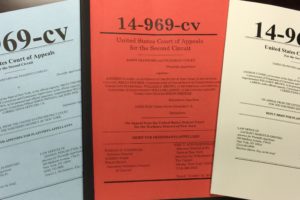Procedural Posture:
I represent Sharrif Wilson. His co-defendant, Antonio “Tony” Yarbough, is represented by Zachary Margulis-Ohuma and Philip Smallman.
We have sought release of our clients who have been incarcerated since June 1992. They were convicted for the triple homicide of Yarbough’s mother, 12 year-old sister, and another 12 year-old girl.
The case (No. 7325-92), February 6th, at 2pm, was heard by the Honorable Luis Guzman, Justice New York Supreme Court, Criminal Term, Kings County (320 Jay Street, 19th Floor). The newly-elected Kings County District Attorney, Ken Thompson, had arranged for Yarbough to be brought down from Attica, so he could be in court on this afternoon.
At this time, both Yarbough and Wilson have been freed and their cases dismissed on consent of the District Attorney. Wilson had been previously brought down to Riker’s from an upstate prison. He has been here for several months while I have been coordinating the final phase of the exoneration investigation with one of the senior homicide prosecutors in Brooklyn, Assistant District Attorney Mark Hale.
These two men being exonerated is part of a much bigger story in New York City. There are now over sixty exoneration cases that have recently flooded the Brooklyn DA’s Office following the March 2013 exoneration of David Ranta. That non-DNA case resulted from a false confession. As a result, every case made by Detective Louis Scancarella has been cast in doubt. The cases of Wilson and Yarbough also involve false confessions (as well as DNA) but with different detectives, so these exonerations will lead to even more cases being questioned.
Case Background:
On June 18, 1992, after a night out in the West Village, Wilson and Yarbough returned to Coney Island. Wilson went to sleep at a friend’s while Yarbough went home to find the bodies of his mother, Annie Yarbough, his 12-year-old sister, Chavonn Barnes, and a friend, 12-year-old Latasha Knox.
Yarbough and his family lived in a drug-ridden housing project. As soon as Yarbough discovered the bodies, he ran outside and found his uncle, Major Yarbough, waiting for a bus across the street. Together, they called the police from a neighbor’s phone. After the police arrived, Yarbough voluntarily went with them to the precinct to give a statement. Wilson, with whom Yarbough had been out the night before, went with Yarboough to the precinct to keep him company after Yarbough’s shock finding his family murdered. Yarbough was 18, and Wilson was 15.
The crime scene Yarbough and his uncle had discovered was grisly: all three victims had been choked to death with electrical cords and stabbed multiple times. The two girls had been partially undressed. Annie was a heroin addict and witnesses told police about a parade of drug users who came in and out of the apartment that night. One of them, the witnesses told police, threatened Annie with a knife after she failed to deliver his drugs.
After a few hours at the precinct, Wilson and Yarbough got placed into separate interview rooms. Brooklyn detectives then “solved” this brutal triple homicide by coercing false confessions from the two boys.
Wilson and Yarbough were convicted after separate trials. Evidence against Yarbough included Wilson’s testimony, which he recanted in writing in 2005. New DNA reveals that the true killer went on to kill again in 1999 while Wilson and Yarbough were locked up. Specifically, as part of the investigation, we arranged for the Office of the County Medical Examiner to test, for the first time, large amounts of physical evidence recovered from the scene. Scrapings from under the fingernails of Yarbough’s mother matched sperm from an unsolved 1999 rape and murder of a woman, Migdalia Ruiz, in Sunset Park, Brooklyn.
Among the mountain of additional evidence exonerating Wilson and Yarbough, the medical examiner’s autopsy established that the murder did not take place in the manner as Wilson and Yarbough had falsely confessed. For example, since the victims had ruptured blood vessels in their eyeballs and no bleeding from their wounds, the victims had been strangled prior to being stabbed, which did not conform to the murder sequence in the false confessions (stabbed, then cord wrapped around the victims’ throats). In addition, other evidence established that Wilson and Yarbough were in Manhattan when the murders took place. Specifically, by 10:35am, riga mortis had set in, meaning the victims were killed around eight to ten hours earlier, a time when other evidence placed Wilson and Yarbough in Manhattan, miles away from Coney Island. In addition, all three bodies had undigested food in their stomachs — further indication that the murders took place much earlier than 6:30 a.m.
The trial lawyers missed these points, never interviewing the medical examiner, or explaining to the jury that the murders could not have happened how and when the boys had falsely confessed. There was even more systemic breakdown because Yarbough’s lawyer had never before tried a murder case. And, the assigned counsel administrator convinced her to stay on the matter despite the attorney expressing concerns about her lack of experience.
Wilson was tried first and convicted. He testified at his own trial, explaining how the police coerced him into falsely confessing to the crime. He was convicted and faced a minimum of 27-years-to-life. But the assistant DA on the case, now a New York judge, offered Wilson a deal: the DA’s office would agree to cut his sentence to nine-years-to-life if he would change his story and testify against Yarbough. Wilson did that — and Yarbough’s first trial ended in a mistrial despite Wilson’s testimony. In the second trial, the jury watched the videotaped confession that Wilson had made in the police station. The tape was not allowed at the first trial. Yarbough got convicted of the three murders in February 1994. He was sentenced to the maximum, 75-years-to-life in prison.
In 2005, Wilson wrote Yarbough’s family that he had lied at Yarbough’s trial. He also testified before the Parole Board that he and Yarbough did not commit the murders. In 2010, Yarbough’s lawyer filed papers in Brooklyn Supreme Court seeking Yarbough’s release based on Wilson’s recantation and errors made at the trial. Then-Brooklyn DA Charles Hynes opposed the motion but agreed to test some items recovered from the crime scene. The Court rejected the first motion in January 2012 on procedural grounds, but held DA Hynes to his agreement to test items found at the crime scene. In response, Yarbough’s trial lawyer provided an affidavit explaining what went wrong at the trial, including her failed attempt to get off the case because her lack of experience. That affidavit finally got the attention of Justice Guzman. Since that time, the investigation has revealed: (1) the DNA from under Annie Yarbough’s fingernails were connected to the unsolved 1999 rape and murder of Migdalia Ruis in Sunset Park; (2) Wilson’s DNA is not on Yarbough’s mother, sister or sister’s friend; (3) Wilson passed a state-of-the-art “probably lie” polygraph conducted by an examiner who works for the U.S. Defense Department; and (4) Wilson has been thoroughly debriefed by the Brooklyn DA’s office.
In addition to the foregoing, we know the District Attorney’s Office has met directly with the family of Latasha Knox, and is scheduled to meet this morning with the Barnes family. Victim family consultations immediately prior to a release decisions are standard pre-exoneration protocol. So, it seems that everything is in place for the case to break in full this afternoon at 2pm with the vacating of their convictions and release.
Have you been charged with homicide in New York?
Contact us today for a free consultation: (646) 742-9800




You must be logged in to post a comment.